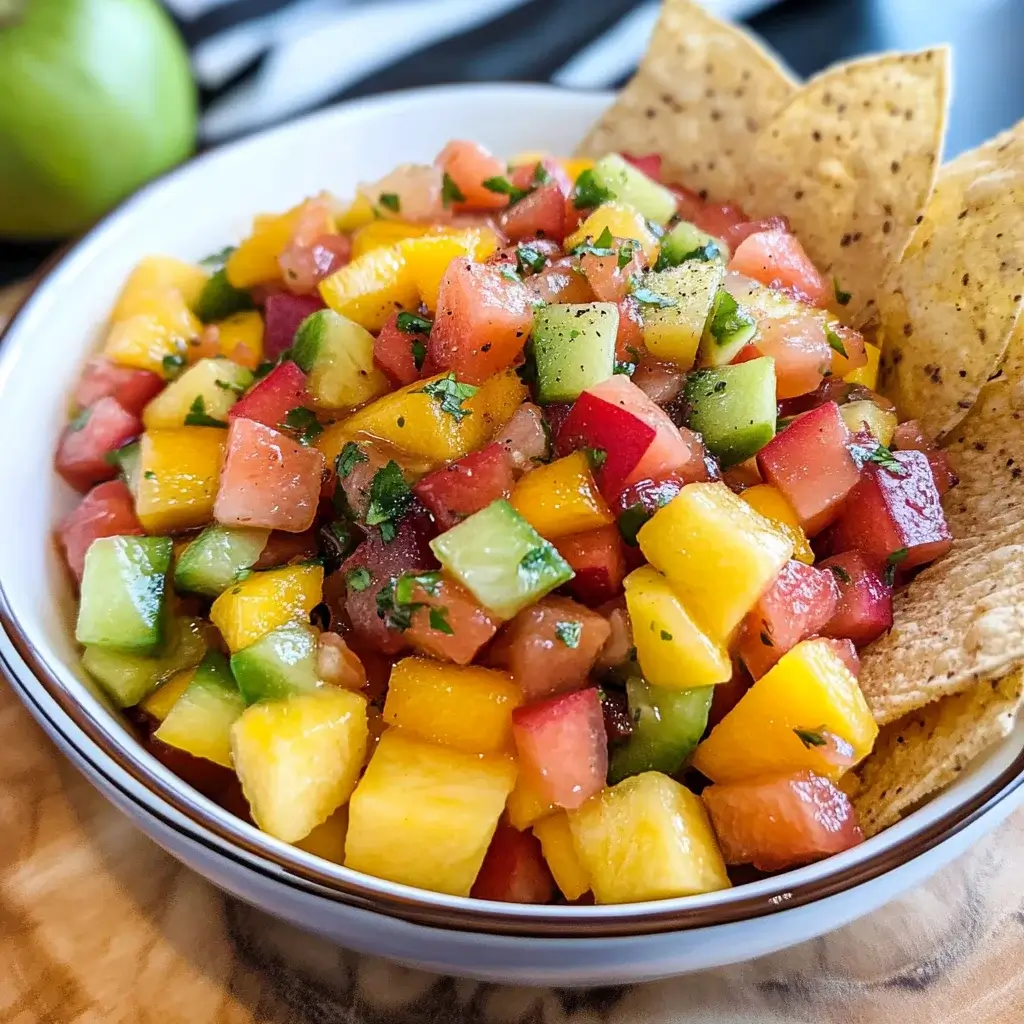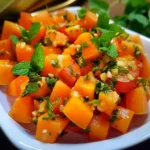In our home, summer isn’t just a season; it’s a state of mind, a vibrant explosion of flavors and colors that we eagerly welcome onto our plates. And nothing embodies the essence of summer quite like a bowl brimming with Tropical Fruit Salsa and a mountain of crispy tortilla chips. This isn’t just a recipe; it’s a tradition, a dish that has graced countless barbecues, pool parties, and lazy afternoons spent basking in the sun. From the moment I first tossed together the juicy mangoes, sweet pineapples, and zesty lime, it was love at first bite. The kids, initially skeptical of “fruit in salsa,” were instantly converted, dipping chip after chip into the vibrant mixture. Even my spice-loving husband, usually drawn to fiery salsas, was captivated by the refreshing sweetness and subtle heat. This Tropical Fruit Salsa is more than just an appetizer; it’s a celebration of fresh, wholesome ingredients, a testament to the simple joy of good food shared with loved ones. It’s the kind of dish that disappears in minutes, leaving behind empty bowls and happy smiles, and the constant request for “more!”. Whether you’re looking for a crowd-pleasing snack, a light and healthy side dish, or just a burst of tropical sunshine in your day, this recipe is guaranteed to become a new favorite. Prepare to be transported to a sun-drenched paradise with every scoop!
Ingredients for Tropical Fruit Salsa
- 1 ripe Mango, diced (about 1 cup): Choose a mango that is slightly firm to the touch but yields to gentle pressure. The sweetness of the mango forms the base of the salsa’s tropical flavor.
- 1 cup diced Pineapple (fresh or canned, drained): Fresh pineapple is preferred for its vibrant flavor and texture. If using canned, ensure it’s packed in juice and drain it well to avoid a watery salsa.
- 1/2 cup diced Red Onion: Red onion provides a pungent bite that balances the sweetness of the fruit. Dice it finely to ensure even flavor distribution and avoid overpowering the other ingredients.
- 1/2 cup diced Red Bell Pepper: Red bell pepper adds a touch of sweetness and a satisfying crunch, along with a vibrant color contrast.
- 1/4 cup chopped Cilantro (fresh): Fresh cilantro brings a bright, herbaceous note that is essential for authentic salsa flavor. Make sure to use fresh cilantro for the best taste.
- 2 tablespoons Lime Juice (freshly squeezed): Fresh lime juice is key for acidity and brightness. It balances the sweetness and prevents the fruit from browning while enhancing all the flavors.
- 1 tablespoon Jalapeño, finely minced (optional, adjust to taste): Jalapeño provides a gentle heat that adds complexity to the salsa. Remove seeds and membranes for milder heat, or leave some in for a spicier kick.
- 1 tablespoon Honey or Agave Nectar (optional, to taste): Depending on the sweetness of your fruit, you might want to add a touch of honey or agave to enhance the overall sweetness and balance the acidity.
- Pinch of Salt: Salt enhances all the flavors in the salsa and brings them together. Use sea salt or kosher salt for the best taste.
- Tortilla Chips, for serving: Choose your favorite tortilla chips. Restaurant-style, thicker chips are ideal for scooping up the salsa. Consider blue corn or multi-grain chips for variety.
Instructions for Making Tropical Fruit Salsa
- Prepare the Fruits and Vegetables: Begin by carefully washing all your fruits and vegetables. Peel the mango and pineapple, if using fresh. Dice the mango, pineapple, red onion, and red bell pepper into small, uniform pieces, about ¼ inch in size. Finely mince the jalapeño, removing seeds and membranes for less heat if desired. Chop the fresh cilantro. Precise dicing ensures even distribution of flavors and textures in every bite.
- Combine Ingredients in a Bowl: In a medium-sized bowl, gently combine the diced mango, pineapple, red onion, red bell pepper, minced jalapeño (if using), and chopped cilantro. Be careful not to overmix, as this can bruise the fruit and make the salsa mushy.
- Add Lime Juice and Season: Pour the fresh lime juice over the fruit mixture. This not only adds a zesty flavor but also helps to prevent the fruit from browning. Sprinkle a pinch of salt over the salsa. If you prefer a sweeter salsa, add honey or agave nectar, starting with a teaspoon and adding more to taste. Remember that the sweetness of the fruit can vary, so adjust the sweetener accordingly.
- Gently Toss to Combine: Using a spoon or spatula, gently toss all the ingredients together until they are evenly distributed and coated with the lime juice and seasonings. Again, avoid overmixing to maintain the texture of the fruit.
- Taste and Adjust Seasoning: Taste the salsa and adjust the seasoning as needed. You might want to add more lime juice for extra tang, more salt to enhance the flavors, or more jalapeño for extra heat. This is the crucial step to personalize the salsa to your taste preferences.
- Chill (Optional but Recommended): For the best flavor, cover the bowl with plastic wrap or a lid and refrigerate the salsa for at least 30 minutes before serving. Chilling allows the flavors to meld together and enhances the refreshing quality of the salsa. While it can be served immediately, chilling truly elevates the taste.
- Serve with Tortilla Chips: Just before serving, give the salsa a gentle stir. Transfer it to a serving bowl and surround it with a generous amount of tortilla chips. Enjoy the vibrant colors and fresh flavors of your homemade Tropical Fruit Salsa!
Nutrition Facts for Tropical Fruit Salsa (per serving, approximate)
(Based on a serving size of about 1/2 cup. Nutritional values can vary based on specific ingredients and portion sizes.)
- Calories: Approximately 80-100 calories per serving: This salsa is a light and refreshing snack option, relatively low in calories compared to many dips and appetizers. It’s a guilt-free way to enjoy a flavorful treat.
- Vitamin C: Excellent source of Vitamin C: Mangoes, pineapples, and bell peppers are all packed with Vitamin C, a powerful antioxidant that supports immune function and skin health. This salsa is a delicious way to boost your daily intake of this essential vitamin.
- Fiber: Good source of Dietary Fiber: Fruits and vegetables contribute dietary fiber, which aids in digestion, promotes satiety, and helps regulate blood sugar levels. Fiber is crucial for maintaining a healthy digestive system.
- Antioxidants: Rich in Antioxidants: The vibrant colors of the fruits and vegetables indicate a high concentration of antioxidants, which help protect your body against cell damage from free radicals. Enjoy the health benefits along with the delicious taste.
- Naturally Low in Fat and Sodium: This salsa is naturally low in fat and sodium, making it a healthy choice for those watching their intake. It’s a flavorful way to enjoy fresh produce without added unhealthy fats or excessive salt.
Preparation Time for Tropical Fruit Salsa
- Prep Time: 15-20 minutes: This recipe is incredibly quick and easy to prepare. Most of the time is spent chopping the fruits and vegetables. With minimal effort, you can have a vibrant and delicious salsa ready in minutes. It’s perfect for last-minute gatherings or a quick snack.
- Chill Time: 30 minutes (optional but recommended): While you can serve the salsa immediately, chilling it for at least 30 minutes allows the flavors to meld and deepen, resulting in a more harmonious and refreshing taste. This chill time is hands-off, so you can prepare other dishes or relax while the salsa enhances its flavors.
How to Serve Tropical Fruit Salsa
- With Tortilla Chips: The classic and most popular way to enjoy Tropical Fruit Salsa is with a generous pile of tortilla chips. Choose your favorite type – restaurant-style, blue corn, multi-grain, or even baked chips for a lighter option.
- As a Topping for Grilled Fish or Chicken: The bright and refreshing flavors of the salsa pair beautifully with grilled fish, chicken, or even pork. Spoon it over your protein for a burst of tropical sweetness and acidity that cuts through the richness of the grilled meats.
- With Tacos or Fajitas: Elevate your tacos or fajitas by adding a scoop of Tropical Fruit Salsa. It complements both savory and spicy fillings and adds a delightful textural contrast.
- As a Side Salad: Serve a bowl of Tropical Fruit Salsa alongside grilled or roasted dishes as a refreshing and colorful side salad. It adds a vibrant element to any meal and is a welcome alternative to traditional green salads.
- Over Cream Cheese or Brie: For a sophisticated appetizer, spread cream cheese or baked brie on a platter and top with Tropical Fruit Salsa. Serve with crackers or baguette slices for a delightful sweet and savory combination.
- In Lettuce Wraps: For a light and healthy meal, spoon the Tropical Fruit Salsa into crisp lettuce wraps. Add grilled shrimp or shredded chicken for extra protein and a satisfying, low-carb meal.
- As a Dessert Topping: Surprisingly, Tropical Fruit Salsa can also be served as a light and refreshing dessert topping. Try it over vanilla ice cream, yogurt, or even grilled pound cake for a unique and flavorful twist.
Additional Tips for the Best Tropical Fruit Salsa
- Choose Ripe but Firm Fruits: The key to a great fruit salsa is using fruits that are ripe but still firm enough to hold their shape when diced. Overripe fruit will become mushy and watery, affecting the texture and flavor of the salsa. Look for mangoes and pineapples that yield slightly to pressure but are not too soft.
- Adjust the Heat to Your Preference: Jalapeño adds a wonderful kick to the salsa, but you can easily adjust the heat level to your liking. For a milder salsa, remove all the seeds and membranes from the jalapeño. For a spicier salsa, leave some seeds and membranes intact, or add a pinch of red pepper flakes. You can even substitute with a milder pepper like poblano for a different flavor profile with less heat.
- Don’t Overmix: Gently toss the ingredients together to combine. Overmixing can bruise the fruit and make the salsa watery and less appealing. Treat the ingredients with care to maintain their texture and freshness.
- Make it Ahead (But Not Too Far): Tropical Fruit Salsa is best when made a few hours ahead of time to allow the flavors to meld. However, it’s not recommended to make it more than 4-6 hours in advance, as the fruit can start to break down and become too soft. If making ahead, store it in an airtight container in the refrigerator.
- Add Other Tropical Fruits: Feel free to experiment with other tropical fruits to customize your salsa. Papaya, kiwi, starfruit, or even passion fruit can be delicious additions. Consider the sweetness and texture of each fruit when making substitutions or additions to maintain a balanced flavor profile.
- Use Fresh Lime Juice: Freshly squeezed lime juice is essential for the best flavor. Bottled lime juice often lacks the brightness and zest of fresh lime juice. The acidity of fresh lime juice also helps to preserve the color and texture of the fruits.
- Consider Adding Avocado (Just Before Serving): For a creamier and richer salsa, you can add diced avocado. However, avocado tends to brown quickly, so it’s best to add it just before serving. Gently fold in diced avocado for a luxurious touch and healthy fats.
- Garnish for Presentation: Before serving, garnish your Tropical Fruit Salsa with extra chopped cilantro or a few lime wedges for a visually appealing presentation. A sprinkle of toasted coconut flakes can also add a delightful tropical touch and textural contrast.
Frequently Asked Questions About Tropical Fruit Salsa
Q1: Can I make Tropical Fruit Salsa spicier?
A: Absolutely! To make your salsa spicier, you can increase the amount of jalapeño, leave some seeds and membranes in the jalapeño, or add a pinch of red pepper flakes. You could also experiment with other hot peppers like serrano or habanero for different flavor profiles and heat levels. Start with a small amount and taste as you go to reach your desired level of spiciness.
Q2: Can I use canned pineapple instead of fresh?
A: Yes, you can use canned pineapple if fresh pineapple is not available. Make sure to choose pineapple packed in juice, not syrup, and drain it very well to avoid making the salsa too watery. Fresh pineapple will always provide a brighter and more vibrant flavor and texture, but canned pineapple is a convenient substitute.
Q3: How long does Tropical Fruit Salsa last in the refrigerator?
A: Tropical Fruit Salsa is best enjoyed fresh, but it can be stored in an airtight container in the refrigerator for up to 2-3 days. However, the texture of the fruit may soften slightly over time. The lime juice will help to preserve it, but for the best flavor and texture, it’s recommended to consume it within the first day or two.
Q4: Can I make Tropical Fruit Salsa ahead of time for a party?
A: Yes, you can prepare Tropical Fruit Salsa a few hours ahead of time for a party. In fact, chilling it for about 30 minutes to an hour allows the flavors to meld and deepen. However, it’s not recommended to make it more than 4-6 hours in advance, as the fruit can start to lose its texture. If making ahead, store it covered in the refrigerator and give it a gentle stir before serving.
Q5: What are some good chip alternatives to serve with Tropical Fruit Salsa?
A: While tortilla chips are classic, you can get creative with chip alternatives. Consider plantain chips for a tropical twist, cinnamon sugar pita chips for a sweeter option, or even cucumber slices or bell pepper strips for a low-carb and refreshing alternative. For a heartier option, try serving it with toasted baguette slices or crostini.
Q6: Can I add other vegetables to Tropical Fruit Salsa?
A: Yes, you can definitely add other vegetables to your Tropical Fruit Salsa to customize it. Diced cucumber, corn (fresh or grilled), jicama, or even black beans can be delicious additions, adding different textures and flavors. Experiment with your favorite vegetables to create unique variations.
Q7: Is Tropical Fruit Salsa vegan and gluten-free?
A: Yes, Tropical Fruit Salsa is naturally vegan and gluten-free. It’s made entirely of plant-based ingredients and does not contain any gluten. Just be sure to check the ingredients of your tortilla chips if you are serving it with chips to ensure they are also gluten-free if needed.
Q8: Can I freeze Tropical Fruit Salsa?
A: Freezing Tropical Fruit Salsa is not recommended. Freezing and thawing will significantly alter the texture of the fresh fruits, making them mushy and watery. The salsa is best enjoyed fresh for optimal flavor and texture. It’s better to make it fresh when you are ready to enjoy it.






